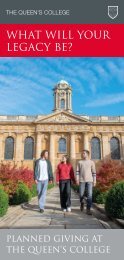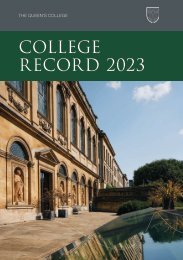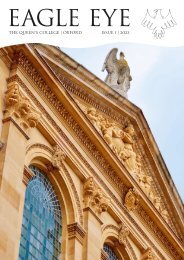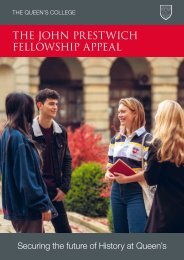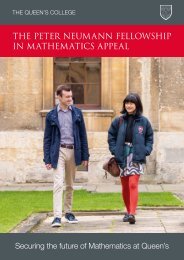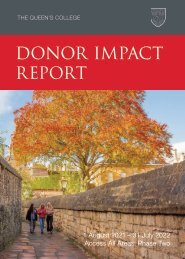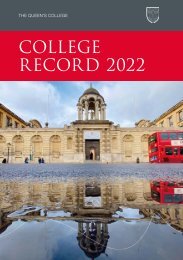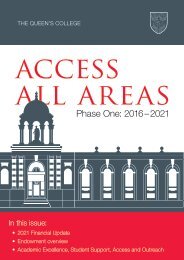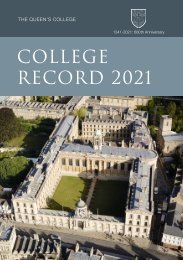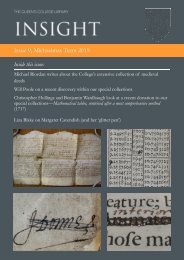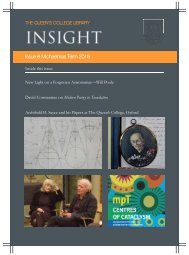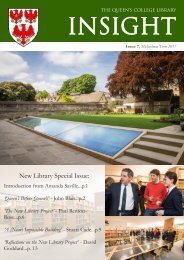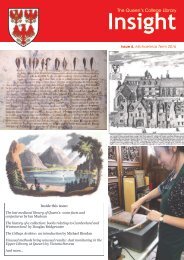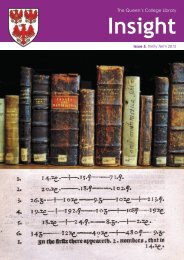The Queen's College Newsletter: Trinity Term 2019
As well as the usual College news, this edition focuses on the different work being undertaken at the College to explore the importance of languages: from bringing creative translation to classrooms in Oxfordshire, to examining ancient texts and gleaning new knowledge about past cultures. This Newsletter also includes the final letter from Provost Professor Paul Madden before his retirement.
As well as the usual College news, this edition focuses on the different work being undertaken at the College to explore the importance of languages: from bringing creative translation to classrooms in Oxfordshire, to examining ancient texts and gleaning new knowledge about past cultures. This Newsletter also includes the final letter from Provost Professor Paul Madden before his retirement.
- No tags were found...
Create successful ePaper yourself
Turn your PDF publications into a flip-book with our unique Google optimized e-Paper software.
THE QUEEN’S COLLEGE<br />
www.queens.ox.ac.uk<br />
<strong>The</strong> Centre for Manuscript and Text Cultures<br />
A glimpse of Ancient Egypt<br />
Queen’s has always supported a diverse and dynamic research<br />
community. With the encouragement of the Provost, the <strong>College</strong><br />
has recently created two research centres to build on shared<br />
research interests among its senior and<br />
junior members: <strong>The</strong> Queen’s <strong>College</strong><br />
Translation Exchange (see pages 14-15)<br />
and <strong>The</strong> Centre for Manuscript and<br />
Text Cultures (CMTC), which crystallizes<br />
an initiative launched by our Fellow in<br />
Chinese Philosophy, Dr Dirk Meyer, in<br />
2012 as <strong>The</strong> Workshop for Text and<br />
Manuscript Cultures.<br />
CMTC is an inter-disciplinary research<br />
centre and academic melting-pot for the<br />
study of material text cultures and their<br />
written artefacts from a broad range of<br />
pre-modern cultures, including ancient<br />
China, Mesopotamia, Egypt, Greece,<br />
Rome, and medieval Europe. It draws<br />
on the interests of Queen’s Fellows in<br />
Oriental Studies, Egyptology, Classics,<br />
and Ancient History, and of colleagues in other colleges in<br />
Egyptology, Sinology, and Medieval English and German.<br />
Through its activities it aims to enable informed debate across<br />
subject boundaries and to contribute to shaping an emerging<br />
field of enquiry into the material factors of knowledge production<br />
across societies.<br />
<strong>The</strong> Centre has a regular programme of workshops for doctoral<br />
students and for early career academics, together with a<br />
research seminar in sixth week each term given by distinguished<br />
invited scholars on topics ranging from ‘Ancient Mesopotamian<br />
Concepts of Disease and Cure’, through ‘Epigraphic Mania<br />
in the North Arabian Desert’, ‘Literacy<br />
and Numeracy in a Babylonian Village’,<br />
‘Scrutinizing the Qur’an in Western<br />
Europe’, ‘<strong>The</strong> Zhou Bronzes and the<br />
Shaping of Tetrasyllable Poems in China’,<br />
to ‘Why Medieval Users Rubbed and<br />
Kissed their Manuscripts’.<br />
<strong>The</strong> Centre has a Junior Research Fellow,<br />
Dr Selena Wisnom, whose work on<br />
Babylonian divination has reached the<br />
columns of <strong>The</strong> Times, and a doctoral<br />
student in Sanskrit, Fabienne Heuze,<br />
who is supported by the John P. Clay<br />
Scholarship. <strong>The</strong> Centre’s Director is<br />
Dr Dirk Meyer.<br />
CMTC has an international advisory<br />
board and has begun to build a research<br />
network with similar centres in Germany, China, and Hong<br />
Kong. Most excitingly, it is about to launch an open-access<br />
journal, Manuscript and Text Cultures, the only one of its kind,<br />
to publish research in annual themed issues devoted to specific<br />
questions placed in cross-cultural contexts. <strong>The</strong> first issue will<br />
appear in 2020, edited by Dr Christelle Alvarez and Dr Yegor<br />
Grebnev, and will examine the question of Transposition and<br />
Monumentality in Writing.<br />
www.queens.ox.ac.uk/centre-manuscript-and-text-cultures<br />
A new display in the relocated Peet Library has brought some of<br />
the colours and textures of ancient Egypt into the <strong>College</strong>.<br />
Thomas Eric Peet (Reader and Professor designate of<br />
Egyptology 1933–1934) was notable for studying Ancient<br />
Egypt in its own terms and worked in an interdisciplinary<br />
manner. Peet, like many of his successors, was appreciative<br />
of Queen’s for being ‘most kind to me in every way’, and he is<br />
commemorated in the <strong>College</strong> by the Peet Library, a collection<br />
of Egyptology books that is used by Egyptologists across the<br />
University, and which is now part of the New Library.<br />
<strong>The</strong> case includes artefacts from the <strong>College</strong>’s collection with<br />
the addition of some pieces donated for display by descendants<br />
of T. E. Peet. <strong>The</strong> new permanent display is intended to give<br />
readers a sense of the material reality of this ancient culture,<br />
which can often be lost in academic accounts and publications.<br />
Professor of Egyptology, and former British Museum curator,<br />
Richard Bruce Parkinson is behind the new installation, assisted<br />
by Dr Ann-Katrin Gill (Univ.) and Barns Student Jordan Miller.<br />
He said: ‘publications inevitably fail to capture a full sense of<br />
ancient experience. <strong>The</strong> display aims to remind library users of<br />
the physical presence of Egypt, through its stone and ceramics,<br />
and to break down the institutionalised habit of conceiving that<br />
culture in somewhat abstract terms. I wanted the readers to<br />
have the same privilege that curators have when they work with<br />
artefacts in a museum collection on a daily basis – a familiar<br />
touch of the real’.<br />
Most of the artefacts, like much ancient data, are from funerary<br />
contexts, spanning four millennia. <strong>The</strong> display prioritises the<br />
visual qualities of the shapes and materials, producing a simple<br />
uncluttered effect, to complement the architecture of the New<br />
Library. Detailed information on each piece is available online<br />
(https://tinyurl.com/PeetDisplay), but there is only an introductory<br />
information panel in the case itself, encouraging viewers to<br />
look rather than to read. Some of the objects are instantly<br />
recognisable as Egyptian, such as the canopic jars (pictured)<br />
intended to hold the internal organs of mummies, but Parkinson<br />
hopes that ‘people will also be struck by the aesthetic qualities<br />
of the banded Egyptian calcite stone and the simple style of<br />
the vessels.’ This, and the fact that their carved faces establish<br />
an immediate engagement with the viewer as they enter the<br />
New Library. <strong>The</strong>y all face into the main library space, apart<br />
from one with the head of a falcon deity, which now faces into<br />
the Peet Library, as its head looks distractingly like a budgerigar<br />
(the poorly carved head will remind readers that a human hand<br />
was involved in the carving!).<br />
Ancient Egyptian texts have been central to Egyptology at<br />
Queen’s, and a key piece is a round-topped limestone stela<br />
(a carved stone slab) made around 1700 BC for an official<br />
named Khentykhetyemhat, containing a Hymn to Osiris.<br />
This poetic hymn to the god of the dead alludes to his triumph<br />
over his enemies as resurrected ruler of Egypt. A duplicate of<br />
this stela in the British Museum contains the same hymn, raising<br />
issues of text transmission and workshop practices; the higher<br />
quality of the carving on the Queen’s stela suggests that<br />
Khentykhetyemhat might even have been unsatisfied with the<br />
work of the first stela and ordered a second.<br />
Whether you’re a student of Egyptology or not, this exhibition<br />
allows you to take a closer look at this fascinating period of<br />
world history as well as prompting reflection on the nature and<br />
function of academic spaces: a reminder of the material reality,<br />
aesthetic beauty and even the fallible humanity of ancient<br />
works of art.<br />
If you’d like to view the display, please contact the library on<br />
01865 279213; please note that visiting is restricted during<br />
examination periods.<br />
<strong>The</strong> <strong>College</strong> has a long association with the study of Ancient<br />
Egypt, beginning with Francis Llewellyn Griffith, a Fellow of<br />
Queen’s and the first Professor of Egyptology at Oxford<br />
(1924–1932). In 1939 the Griffith Institute was founded in his<br />
memory, and it remains at the heart of the subject in Oxford<br />
(www.griffith.ox.ac.uk). <strong>The</strong> Griffith Institute has a strong spirit of<br />
collaboration with Queen’s and has supported the <strong>College</strong> with<br />
research on the new display.<br />
Photo © David Olds<br />
10 11




